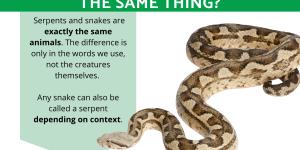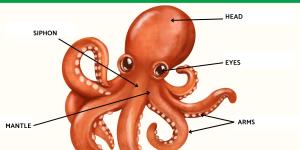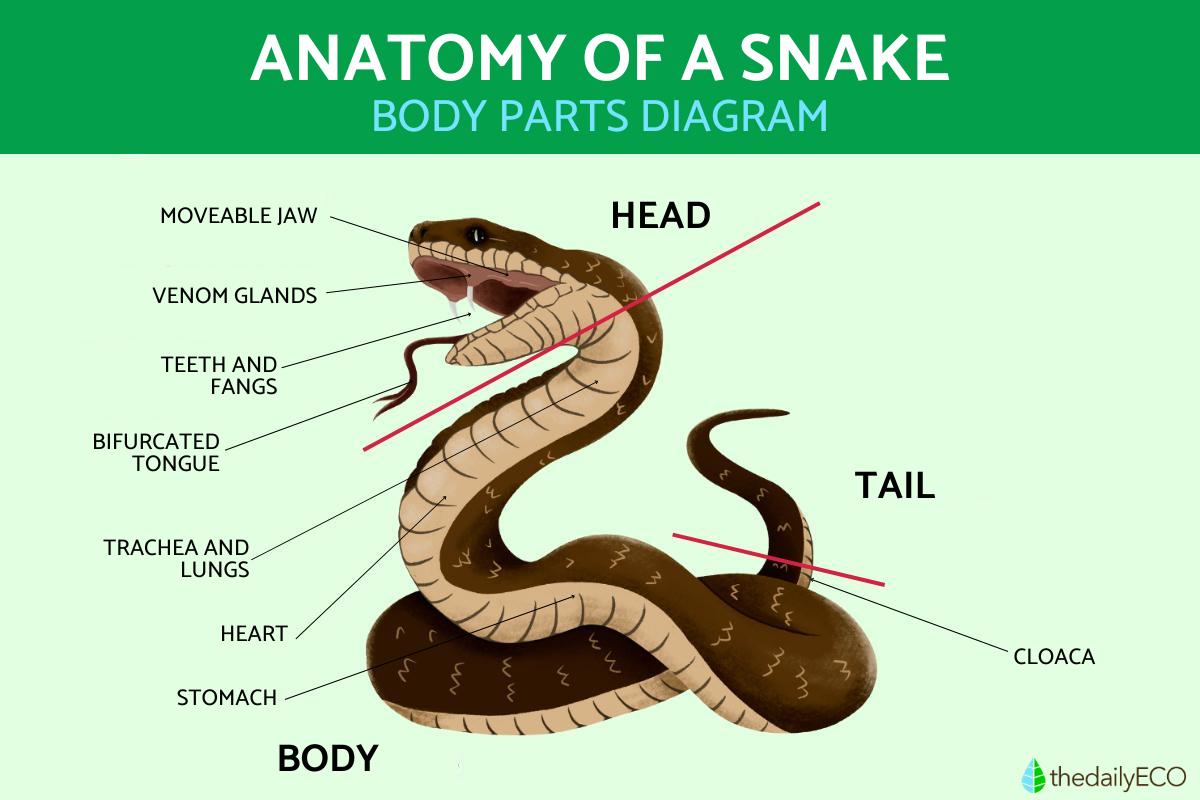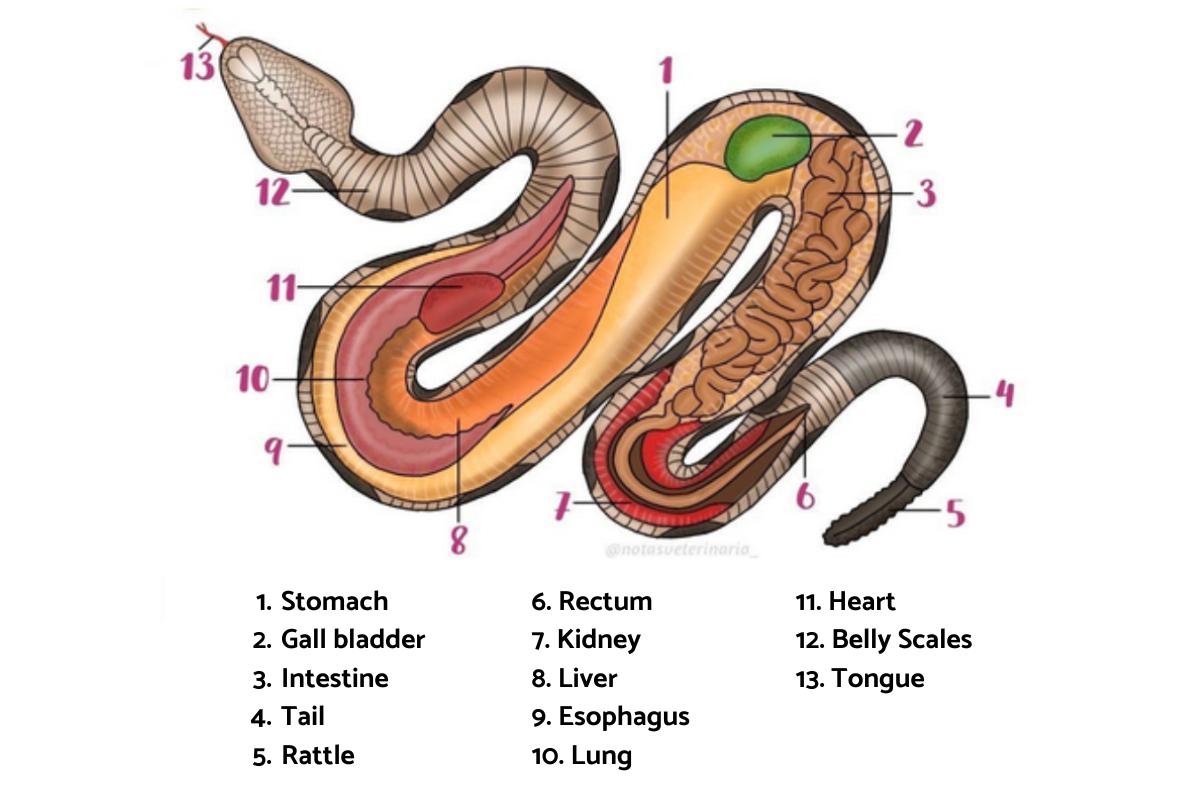Snake Anatomy - Parts of a Snake


Snake anatomy is unique among reptiles. Most notably, they have a complete lack of limbs and a very elongated body which can be many feet in length. They also have specialized sensory organs, lidless eyes and other features, some of which are not common to all snakes. For example, some snake species have venom glands while others do not. Snakes have internal organs like other vertebrate animals such as a liver, kidneys, pancreas, lungs and stomach. They also have a cloaca which is used for both reproductive and excretory processes.
At thedailyECO, we look more closely at snake anatomy. We discover the different body parts of a snake with diagrams to help understand why these reptiles are so specially adapted to their environments.
Head of the snake
A snake head can vary in terms of morphology according to species. However, they are generally elongated and flattened. All contain sensory organs, but some have specific adaptations. Others have venom glands which are used to incapacitate prey when the snake bites.
Venom glands
Venomous snakes possess a pair of specialized venom glands, i.e. organs that produce an acidic secretion for incapacitation of prey. They are located at the back of the head, just behind the eyes. They are attached to the frontal fangs which allow the snake to inject the venom after being secreted by the glands. The venom passes through two parts of the snake located in the head:
- Venom-conducting tube: tube that transports venom from the venom gland to the venom canal.
- Venom canal: hollow fissure in the fang that allows venom to be injected when biting.
Learn about this ability in other animal species with our article on the most venomous fish species in the world.
Sensory organs
The sensory organs of a snake are the vomeronasal organ (also known as the Jacobson's organ), forked tongue, thermoreceptor pits, eyes, ears, nose and tactile organs. We explain the sensory body parts of snakes in more detail below:
- Forked tongue: receptors on the snake's tongue pick up on chemicals in the air. They can then identify the particles thanks to a special organ called the vomeronasal (or Jacobson's) organ. This is why we see snakes stick their tongue out and wiggle it around a little.
- Jacobson's organ or vomeronasal organ: this is located on the palate of the snake and has two small entrance holes leading into it. They are like nostrils, but inside the mouth. Once the snake has flicked its forked tongue enough to register enough chemical particles, it brings it back into its mouth and presses the tips of its forked tongues against the organ. Each forked tip is inserted to each hole.
- Thermoreceptor pits: these allow them to perceive temperature variations and locate their prey. They form a cavity between the eye and the nostril.
- Eyes: they have thermoreceptor capacity to detect prey, i.e. they detect the body heat of other organisms, similar to infrared detection.
- Hearing: while they lack external ears, snakes have a middle ear bone that connects the inner ear to the jaw. It has a mechanism to perceive vibrations.
- Nose: external opening of the nasal cavity is located above the mouth, providing both olfactory and respiratory functions.
- Tactile organs: present on the scales, these allow them to perceive contact and texture. They cover the entire body of the snake. They can be smooth, keeled or plate-shaped.
Mobile jaw
The highly mobile bone of the upper jaw allows the snake to swallow large prey. This prey can be significantly larger than the snake itself, sometimes being so large they are unable to digest them and die.
Teeth
Snake teeth have a hard and pointed structure that curves backwards. They are attached to the jaws. As with certain other types of reptile such as crocodiles, snakes are polyphyodontal. This means they have multiple sets of teeth, with newer teeth replacing older ones over time throughout their lives. This is especially helpful when a tooth is lost or damaged. Although they are used to hunt, they do not use them to chew.
Fangs
The fangs of snakes are specially adapted, curved tooth that are located in the jaw. As we have stated, they are connected to the venom gland which allows the snake to inject venom into the soft tissues of their prey. You can see these fangs are prominent in both the snake anatomy diagram above and the picture below.
Learn more about the body of snakes with our article on do snakes have a backbone?

Body of the snake
The body of snakes is characterized by being elongated, cylindrical and lacking limbs. It is covered by scales that protect its skin and give it flexibility and ease of movement. They are also important for abilities such as camouflage, with many snake species mimicking their habitats. The anatomy of a snake body is made up of:
- Esophagus: in snakes, the esophagus has folds that make it elastic, allowing it to accommodate large prey that they ingest whole.
- Gallbladder: this organ stores bile produced by the liver.
- Heart: as with mammalian hearts, snake hearts pump blood to tissues. Unlike mammals, instead of 4 chambers, snake hearts have only 3.
- Intestines: snakes have a small and large intestine, just like humans. These help absorb nutrients from food.
- Liver: this organ produces bile, which helps with the digestion of food.
- Kidneys: kidneys remove waste from the blood and regulate water loss in snakes.
- Lungs: most snake species have one functional lung, while the second lung is smaller. Some species can use this second lung for breathing.
- Pancreas: just like in humans, the pancreas of snakes helps regulate blood sugar levels.
- Stomach: being carnivorous animals, snakes digest their food in their stomach. This is because they do not chew their food like humans.
- Trachea: this tube connects the snake's nose and mouth to the lungs. The entrance to the trachea (glottis) moves o allow the snake to continue breathing while ingesting large prey.
- Cloaca: birds and reptiles have cloacas to excrete waste and lay eggs. The outside of the opening is called the vent.
Learn about other types of reptiles with our article on the difference between crocodiles and alligators.

Snake tail
Unlike other reptiles such as lizards, it is difficult to tell where a snake tail begins. This is due to the elongated and cylindrical shape of the snake. The tail can represent between a quarter and a third of the snake's total body length.
Snake tails are flexible structures that are highly adapted to perform multiple functions. This includes helping with both locomotion and balance. They serve as defense mechanisms by striking or shaking, the latter common in types of rattlesnake. These snakes have specially modified scales at the end of their tail which are hardened and make a noise when they vibrate. Tails are also used to grasp, especially in arboreal snake species.
The snake diagram above shows the body parts of a rattlesnake. If you want to discover more about reptiles, take a look at our article on the different types of iguanas.

If you want to read similar articles to Snake Anatomy - Parts of a Snake, we recommend you visit our Facts about animals category.
- The California Academy of Sciences. (2021). Snakes. https://www.calacademy.org/sites/default/files/assets/docs/calacademy-sah_snakes_210722.pdf
- Visual Dictionary Online. (n.d.). Morphology of a venomous snake: head. https://www.visualdictionaryonline.com/animal-kingdom/reptiles/snake/morphology-venomous-snake-head.php
- The University of Melbourne. (2020). Sneaky Snake Facts. School of Biomedical Sciences. https://biomedicalsciences.unimelb.edu.au/departments/department-of-biochemistry-and-pharmacology/engage/avru/blog/sneaky-snake-facts








